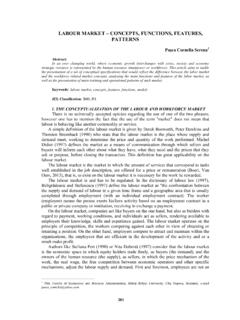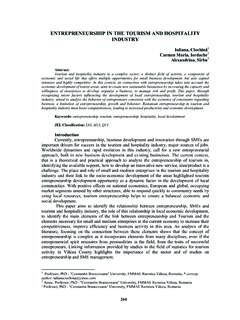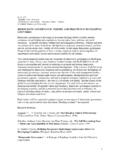Transcription of TALENT MANAGEMENT – OPPORTUNITIES AND …
1 TALENT MANAGEMENT OPPORTUNITIES AND CHALLENGES. RESULTED FROM THE CHANGES CAUSED BY THE ECONOMIC. CRISIS. Iuliana, Talmaciu1. Silvia, Dugan2. Abstract: In the always-changing economic environment of today companies, especially those aiming at expanding in new markets, are faced with major challenges in developing and implementing effective TALENT MANAGEMENT strategies. This article intends to analyze the characteristics of TALENT MANAGEMENT and to emphasize its role in an economic environment that is highly competitive, dynamic and affected by the economic crisis in which companies have major difficulties in developing and implementing effective development strategies.
2 The article also intends to highlight in which measure Romanian companies are preoccupied by the implementation of TALENT MANAGEMENT strategies and how can the retention of talented employees be realized in cost-optimizing conditions. Key words: TALENT MANAGEMENT , employee retention, competences, assessment of performances JEL Classification: O15, J24. 1. Introduction The world has become a labor market without frontiers, where talents are no longer limited by national or even continental borders. The access of talented employees to more complex positions on a globalized labor market has forced employers to invest in cultivating, preserving and keeping talents loyal, in order to maintain a competitive advantage and continuity in business.
3 The measurement of the intellectual capital and of the knowledge MANAGEMENT is not reflected in most cases in the companies' monetary and financial accounting records, the reporting being rather voluntary than mandatory. As such, there is a huge difference between the reporting methods used by companies and in the typology of the indicators reported. (Dindire Laura, Dugan Silvia, 2013). Companies like to promote the idea that employees are their biggest source of competitive advantage but most of them are as unprepared for the challenge of finding, motivating, and retaining capable workers as they were a decade ago.
4 In the most general sense, TALENT is the sum of a person's abilities- his or her intrinsic gifts, skills, knowledge, experience, intelligence, judgment, attitude, character and drive. It also includes the ability to learn and grow. The TALENT is now a critical driver of corporate performance and that a company's ability to attract, develop and retain TALENT will be a major competitive advantage far into the future. (Michaels Ed et al., 2001). TALENT MANAGEMENT means having the right people in the right place, at the right time and most of all at the right cost and it also represents the totality of systems and processes that allow a company to attract develop and preserve highly-qualified employees.
5 Jack Welch, one of the most renowned CEOs in the world and the leader of General Electric for 20 years, had a very interesting theory about the healthiest structure of a company. He considers that the most important part of a company's employees, the talents should represent 20% of the total of employees in a company, while the maneuver part, the ones a company usually changes, are 10%. The rest 70 % are the working part, the ones who guarantee the company functions. He states my main role was to develop 1. PhD Student, Valahia University from T rgovi te, Faculty of Economics, 2.
6 Associate professor, Constantin Br ncoveanu University from Pite ti, Finance-Accounting Faculty Pite ti, 320. talents. I was a gardener, feeding the garden of the 750 top people in the company. Of course, I had to obtain a harvest.. TALENT is not about someone's potential to move into increasingly senior positions. It's about how they perform now and how they deliver tangible and sustainable results. (Davies Jacqueline, Kourdi Jeremy, 2010). At its hart, TALENT MANAGEMENT is simply a matter of anticipating the need for human capital and then setting out a plan to meet it. TALENT MANAGEMENT is not an end in itself.
7 It is not about developing employees or creating succession plans, nor is it about achieving specific turnovers rates or any other tactical outcome. It exists to support the organization's overall objectives, which in business essentially amount to making money. (Cappelli Peter, 2008). SHL The CEB TALENT Measurement Solution has presented the results of the annual study Global Assessment Trends Report which is based on an online survey, filled in by 481. professionals in human resources worldwide, showing that the organizations which will be successful, disregarding economical conditions, are those having a culture centered on the employees, as this culture becomes visible with clients as well.
8 Companies that understand the potential of the internal talents have bigger chances to adapt and succeed in comparison with the other players on the market. However, this depends on their ability to value the competences and the knowledge of the workforce and to recruit candidates that can increase the internal TALENT nursery. An effective TALENT MANAGEMENT begins with a profound understanding of the competences, behaviors and potential in an organization and aligning these coordinates to the present and future business objectives. (Sarah S. Fallaw, et al, 2012). An effective TALENT MANAGEMENT means to clearly differentiate both people and roles.
9 In a market characterized by dynamism and competitiveness, the solutions provided by TALENT MANAGEMENT have a double purpose: identifying, developing and adapting human capital to strategic business objectives and connecting these objectives to the individual objectives of the employees and their long-term development in the company. 2. Paper objectives and methodology of research In performing this paper we aimed to achieve the following objectives: O1: identification of the characteristics of TALENT MANAGEMENT in the knowledge- based economy;. O2: presentation of various TALENT retention solutions within organizations.
10 O3: analysis of the effects of the economic crisis on TALENT MANAGEMENT strategies;. O4: revealing certain aspects related to the trend entitled TALENT market in Romania. In order to achieve the objectives we used as research method the content analysis of the specific studies made by various authors (Fallaw S., Dawson C., Michaels E., Handfild-Jones H., Axelrod B.) and some prestigious international institutions (Pricewaterhouse Coopers, Ernst & Young, etc.). 3. The characteristic of TALENT MANAGEMENT The TALENT MANAGEMENT goes beyond basic employee administration. When well done it ensures that the right employees are in the right positions with the skills and motivation necessary for success.







